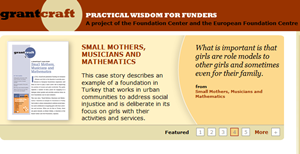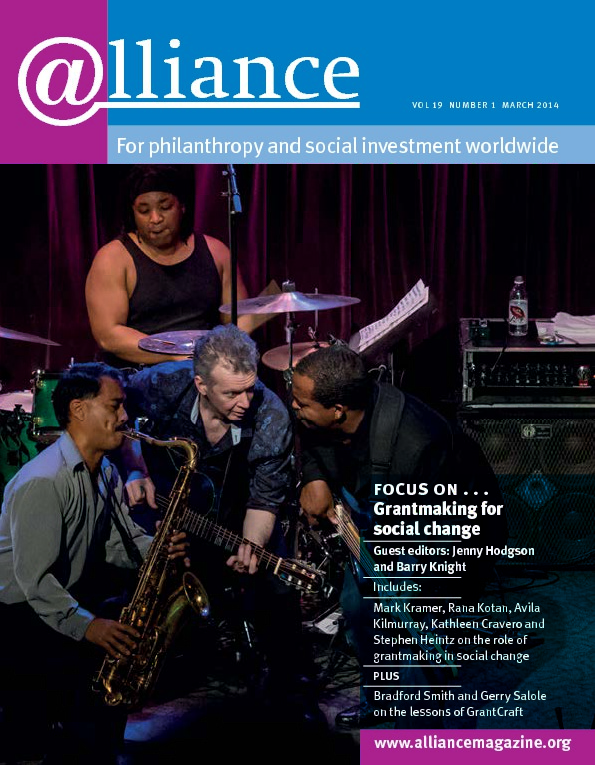GrantCraft – an online and print resource for tapping and sharing the ‘practical wisdom’ of grantmakers – was launched as an operating programme of the Ford Foundation in 2001. Ten years later, the Foundation Center in New York and the European Foundation Centre (EFC) in Brussels won a request for proposals to jointly manage GrantCraft as a global learning platform for professionals in philanthropy. Although the Foundation Center and the EFC will continue to work together on a number of joint projects, our GrantCraft partnership has come to a close after three years. GrantCraft lives on and will continue to grow, managed solely by the Foundation Center as a global resource.
 Since ‘collaboration’ and ‘partnership’ are ideals to which our sector aspires, we thought it would be helpful to share what our organizations have learned during the GrantCraft transatlantic experiment.
Since ‘collaboration’ and ‘partnership’ are ideals to which our sector aspires, we thought it would be helpful to share what our organizations have learned during the GrantCraft transatlantic experiment.
A great deal can be accomplished by working together
In the three years that GrantCraft functioned as a joint initiative of the EFC and the Foundation Center, an enormous amount of new material was produced.
• Some 13 guides, blog series, thought pieces and resources have included Speaking Up!: Foundations and Advocacy in Europe, Blueprint 2014: Philanthropy and the Social Economy, and an Interactive Tool Finder to support funder collaboration.
• GrantCraft guides were translated into languages such as Arabic, Chinese and Portuguese.
• An infographic on ‘Foundations Working Together in Europe’ was translated into French and Spanish, while a second infographic on ‘Funding for Inclusion’ was translated into Turkish and Italian.
• In 2013 alone, 62,110 individuals from over 147 countries visited GrantCraft.org 80,074 times.
Business models matter
GrantCraft was conceived and incubated within the four walls of a richly endowed foundation, and lived there for a decade. It was heavily subsidized by the Ford Foundation, which saw it as a service to the field of philanthropy. Recognizing this, Ford offered a generous grant to ease the transition to GrantCraft’s new owners. But the EFC and Foundation Center have had only modest success in raising additional, dedicated funds. As an organization with a business model that includes online publishing and content aggregation, the Foundation Center is in a better position to maintain and grow GrantCraft in the long term.
Contracts are not good vehicles for partnership
The Ford Foundation made a single grant to the Foundation Center to fund the initial years of the GrantCraft partnership. Since the Foundation Center is not itself a foundation, it could not regrant a portion of those resources to the EFC and resorted to a contract agreement. Though we both worked hard to construct as flexible a contract as possible, it still cast a European organization (the EFC) as a provider of ‘services’ to an American organization (the Foundation Center), for which the former would receive ‘payment’ from the latter. Though all involved worked in good faith, efforts to protect the interests of their respective institutions in the contract negotiations at times resulted in tension and misunderstandings.
Intellectual property is very complicated
As a service of the Ford Foundation, GrantCraft did not really have any tangible assets, but it did have intellectual property. It had a website, a considerable body of copyrighted publications, a logo and a trademark. These were transferred by Ford not to the co-ownership of the joint partners who submitted the proposal but to the single ownership of one of the partners, the Foundation Center.
This threatened to be an inauspicious start: as lawyers for both organizations spent hours trying to figure out some kind of joint governance and arrangements to use this intellectual property, the contract negotiations nearly ground to a halt. In the end we worked it out, including seemingly unpleasant but necessary ‘pre-nuptial’ clauses in the event that one of the partners was unable to continue in the partnership. Along the way, we learned a great deal about the different legal regimes on both sides of the Atlantic and the challenge of finding common ground on the new frontier of intellectual property.
Relationships trump everything else
In GrantCraft’s first months as a joint venture, the relationship between the EFC and the Foundation Center suffered some strain from the difficulties of negotiating a contract. But we both knew that the work had to go on and moved quickly to hire talented staff to direct the future of GrantCraft: Rosien Herweijer in Brussels and Lisa Philp (and later Jen Bokoff) in New York. They travelled to each other’s cities, attended conferences, made joint presentations, and spoke regularly to make sure that GrantCraft was on the right track. Based on the good faith of both organizations and the directors’ hard work, common sense and can-do attitude, GrantCraft got off to a good start and operated for quite some time before a contract was actually signed.
GrantCraft is not the strongest brand for a European venture
While there is a strong tradition of craft in Europe, grants are a different matter. The overwhelming majority of foundations in Europe operate their own programmes rather than grant funds to other organizations. In the US, it is exactly the reverse and there is a long tradition, language and practice around grantmaking. Furthermore, GrantCraft was born inside the Ford Foundation, one of America’s oldest and largest grantmaking institutions. As a result, the name ‘GrantCraft’ was not particularly appealing to European audiences and much of the original content of the website and guides was geared towards philanthropy professionals whose work was to make grants. Some of those guides, covering topics such as gender, exit strategies and scanning the landscape, have proved more universal, as have new, more Europe-focused content produced by the EFC during the partnership. In the end, we jointly decided not to change the brand name, but we did address language and context issues by delivering more universally applicable and understood content. In 2013, European visitors made up 13 per cent of GrantCraft web traffic; we expect this figure to grow in the future.
The needs of membership and non-membership organizations are different
As the premier philanthropic membership organization in Europe, the EFC has a direct constituency – its 231 foundation members. They want skill-building targeted directly to their needs, and the EFC plans to expand its own training programmes to meet this need. American ‘grantmakers’ have a multitude of training options – within their own foundations, through regional associations and affinity groups, from university-based programmes, among others. GrantCraft was never intended to be a training programme per se, but rather a way to codify the practice of professionals in philanthropy and make it widely available to practitioners, consultants and trainers in the US and around the world. GrantCraft guides continue to be used as a resource for discussion and training by others, and the EFC will be using existing and future GrantCraft material as one input in its future training efforts.
 We look forward to a stronger, more realistic partnership in the future
We look forward to a stronger, more realistic partnership in the future
Philanthropy is a field long on good intentions and ripe with cooperation agreements. But many of these never go beyond the desire to do something together within or across borders. The way institutions actually learn about partnership is by working together on something concrete. Taking on GrantCraft together was an enormous transatlantic challenge through which the Foundation Center and the EFC learned a great deal about each other, our comparative strengths and important differences. We continue to work together with a much clearer understanding of how each can benefit from the other’s competencies. Soon, for example, a searchable ‘knowledge centre’ developed jointly by the Foundation Center and the EFC will be launched on the EFC’s website. And there are more ideas in the works.
In the early 1990s, a young Foundation Center staff member, Elan Garonzik (now vice president for program administration at ELMA Philanthropies), was seconded to the visionary ‘start-up’ organization in Brussels that was the EFC. The GrantCraft experiment provided an opportunity to rekindle that historic relationship, learn by doing, and discover the best way for two historic philanthropic organizations to work together in the future across the Atlantic and around the world for the good of our sector.
Bradford Smith is president of the Foundation Center and Gerry Salole is chief executive of the EFC. Emails bks@foundationcenter.org and GSalole@efc.be
They are old and good comrades in arms and will continue to work together.
For more information
Twitter @grantcraft






Comments (0)